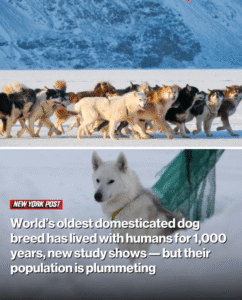The Greenland sled dog, also known as the Qimmeq, has been identified as the world’s oldest domesticated dog breed still living with the same human population for over 1,000 years. According to a recent study published in the journal Science, these dogs have coexisted with the Inuit people of Greenland since they migrated from Siberia roughly a millennium ago, forming a bond that is both cultural and biological.
Researchers analyzed ancient and modern DNA from 92 dogs, including archaeological remains and living sled dogs in Greenland. The findings confirm that the Qimmeq is not only genetically distinct but also remarkably unchanged over the centuries. Despite their wolf-like appearance, Qimmeq are genetically less related to wolves than previously thought and are instead closely tied to early sled dogs brought to Greenland by the Inuit.
These dogs have evolved unique traits that allow them to thrive in the harsh Arctic environment. Adaptations include resistance to cold, strong endurance for sled pulling, and metabolic abilities suited to a high-fat diet, reflecting their historical diet of marine mammal meat. Their development is tied directly to Inuit survival and mobility across the icy terrain of Greenland.
However, the population of these ancient dogs is plummeting. In 2002, there were about 25,000 Greenland sled dogs. By 2020, that number had dropped to around 13,000—a nearly 50 percent decline. Experts warn that without active conservation efforts, the breed could disappear within decades.
The study attributes the decline to multiple factors. Climate change is reducing the amount of sea ice, which traditionally provided essential routes for sled travel. With the melting of ice, sled dog transportation has become less reliable, and many Inuit communities have turned to snowmobiles and other motorized alternatives. This shift reduces the need to breed and care for sled dogs.
Cultural changes are also a significant factor. Younger generations in Greenland are increasingly moving to urban areas, where traditional dog sledding is no longer part of daily life. As a result, fewer families are raising and training sled dogs. The loss of sled dogs is thus not only a biological issue but a cultural one, threatening the traditions of Inuit communities.
Tatiana Feuerborn, a paleogeneticist and lead author of the study, emphasized the importance of preserving this breed, stating, “Dogs have been so intrinsically tied to human history. In Greenland in particular, these dogs have been there all along. Being able to preserve that cultural history alongside the genetic history is important.”
The Qimmeq has been essential for centuries in hunting and transportation, especially in regions of Greenland where roads and modern infrastructure are limited. Their role in traditional hunting expeditions and Arctic exploration has been widely recognized, and their loss would mark the end of a living connection to thousands of years of human-animal cooperation.
Efforts are underway to protect the breed. Greenland has strict regulations to maintain the purity of its sled dogs. Importing dogs from outside the island is banned in certain regions to prevent crossbreeding. Additionally, breeding programs and cultural education are being developed to encourage the preservation of traditional sled dog practices.
Some conservationists are also calling for financial support and international awareness to maintain the Qimmeq population. They argue that just as endangered species are protected in the wild, traditional domesticated animals like the Greenland sled dog deserve attention due to their historical and cultural value.
The study of the Qimmeq provides broader insights into the history of domesticated dogs. While dogs were domesticated over 15,000 years ago, the Greenland sled dog is among the few breeds that have remained closely tied to a specific human culture for an extended period. This makes them a unique subject in the study of human-animal relationships.
Unlike many modern breeds that have undergone extensive hybridization or selective breeding for aesthetic traits, the Qimmeq has remained largely unchanged in function and genetics. This makes it a valuable genetic resource for understanding how dogs adapt to specific environments and roles.
The Qimmeq’s story is also a reminder of the deep connections between people and animals. In the Arctic, where survival depends on cooperation, the relationship between the Inuit and their dogs has been one of mutual reliance. The dogs provided mobility and assistance in hunting, while humans offered food, shelter, and care.
As global warming and modernization reshape life in the Arctic, these ancient bonds are being tested. The decline in sled dog numbers reflects a broader erosion of traditional knowledge and lifestyles among Indigenous Arctic peoples.
Preserving the Qimmeq is not just about saving a dog breed. It’s about protecting a living legacy of Indigenous resilience, adaptation, and culture. As researchers and communities work to ensure the future of these remarkable animals, they are also affirming the value of cultural heritage and ecological stewardship in a changing world.
Experts hope that by raising awareness about the Qimmeq’s significance, more resources and attention can be directed toward protecting the breed and supporting Inuit traditions. The fate of the Greenland sled dog may depend on the willingness of both local and global communities to recognize their importance—not only as animals but as partners in one of the world’s oldest and most enduring human-animal collaborations.


